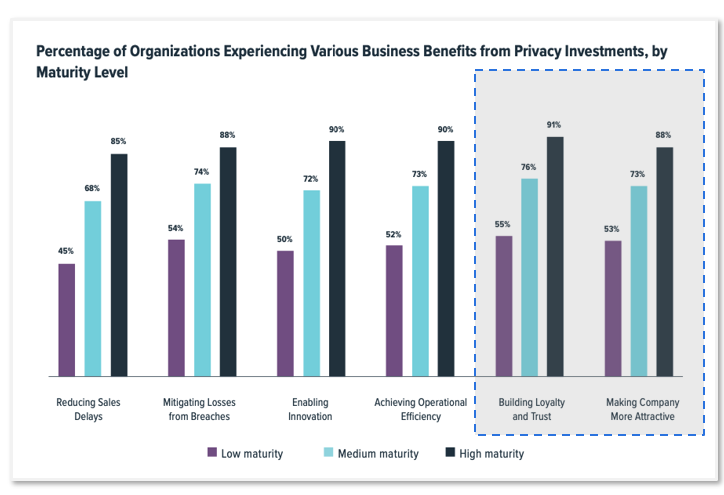The amount of data being created each day is staggering. According to Statista, the total amount of data predicted to be created, captured, copied, and consumed globally last year was 97 zettabytes, a number projected to grow to 181 zettabytes by 2025.
With so much data, brands have plenty of opportunities to know their customers and to use data-driven tactics at every turn. While gleaning the right insights can be tricky and takes some dedication, luckily marketers don’t have to look far to find the right insights to drive their strategies. A brand’s first-party data is the most accessible and the most valuable for those willing to take the extra time to extract value.
Why First-Party Data is Important
- 87% of marketers believe that first-party data is critical for delivering personalized experiences. (Forbes)
- 92% of marketers find first-party data to be the most valuable for targeting and segmentation purposes. (eMarketer)
- Using first-party data for audience targeting leads to an increase in click-through rates by 115%. (Neustar)
- 69% of marketers use first-party data to improve customer retention and loyalty. (Adweek)
- First-party data-driven campaigns have a conversion rate of 60% compared to 2% for non-data-driven campaigns. (Researchscape)
- 78% of businesses consider first-party data essential for building a deeper understanding of their customers. (Econsultancy)
- Companies that leverage first-party data for targeting see a 68% improvement in customer lifetime value. (The CMO Survey)
- First-party data helps reduce customer acquisition costs by 50%. (Forbes)
- 83% of companies that exceeded their revenue goals used first-party data to inform their strategies. (Forbes)
First, Second, Third, and Zero Party Data: How Are They Different?
Marketers today have several types of data that can be used in their marketing efforts – 1st, 2nd, 3rd and zero-party data.
First-Party Data
First-party data is information collected directly from your own customers. It is your proprietary data and includes data from interactions, transactions, and engagements that occur on your platforms. First-party data provides the highest level of accuracy and relevancy since it comes directly from your own audience.
Second-Party Data
Second-party data is obtained through an indirect customer relationship (compared to first-party data, which is a direct customer relationship). This type of data is information the brand didn’t collect but is often obtained by working with a trusted partner that shares audience insights in a mutually beneficial relationship. It may include activity on websites, apps and social media, survey responses, and more.
Third-Party Data
Third-party data is collected by external sources unrelated to your organization. It is aggregated data that is purchased or acquired from data providers or data aggregators. Third-party data is collected from various sources, such as public records, surveys, or online behavior tracking. It provides a wide range of audience insights but may be less accurate or specific to your particular business.
Zero-Party Data
Similar to first-party data, zero-party data is obtained from a direct relationship with the customer and is collected with consent. Examples of zero-party data include communication preferences, product preferences, and customized account configurations. Zero-party data provides a high level of accuracy and reliability, especially when combined with first-party data insights.
How to Leverage First-Party Data as Part of an “All-Party Data” Solution
By combining first, second, third, and zero-party data, you are able to access the most comprehensive view of your customers, which allows you to deliver precisely targeted and personalized marketing.
In the example below, you can see how different types of data from the data ecosystem come together to form a complete view of Mary Smith, a “Pet Care Pros” Customer.
4 Benefits of First-Party Data
With cookie deprecation and privacy legislation top of mind for marketers, first-party data is no longer just a nice have but a must-have in a more tightly regulated landscape. The top four benefits of first-party data include:
1. Hyper-Targeted Personalization
83% of consumers reported an increase in loyalty to a company that offers them a personalized experience. – Twilio
Here are some examples of using first-party data for hyper-targeted personalization:
- Delivering a personalized dashboard when they log onto your website, showing customers items they’ve already viewed or similar items that might interest them
- Adding a free product that you know they’ll like within their delivery
- Sending an email to let them know the item they recently viewed is on sale
2. Target the Right Consumers with the Right Message
Studies by the ANA / Data & Marketing Association found that marketers who implemented segmentation strategies in their marketing campaigns saw an incredible revenue increase of up to 760%.
First-party data can be analyzed to create segmented audiences and drive personalized messaging and experiences.
Examples of first-party data segments include:
- Users who visit your website
- Users who visit certain categories on your website
- Customers who buy most often
- Inactive customers
- High-value customers
- Geography
3. Build Loyalty and Trust with Your Customers
73% of consumers said they’re willing to share more when brands were transparent about the data they collected. – Accenture
Consumers know their data is being used – be transparent about how their data is being used to establish trust and strengthen your customer relationships.

4. Proprietary and Most Accurate
Compared to second and third-party data, first-party data is the most organic and accurate data option – because you gather it directly from your customers. When implementing strategies based on first-party data as the foundation, the benefits to ROAS can be monumental, as seen in the following example.

Conclusion
Investing in all-party data techniques begins with a solid foundation of first-party data. This unlocks more engaging customer relationships, brand loyalty, and new revenue streams. Start with clear goals – what are you looking to achieve? Better customer experiences, customer retention strategies, acquire more customers? Or all of the above? Once you have a clear goal in place, research the best methods, technologies, and platforms to help you achieve the best possible outcomes.





